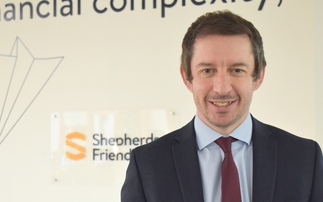After much talk of a generic industry-wide protection campaign it seems the ball has started rolling. Paul Robertson explains the what it hopes to achieve and how it may impact the industry.
It has been widely reported that the reinsurance and provider portions of the protection insurance industry have formed a committee to look into the possibility of a national campaign aimed at boosting protection sales in the UK. But what does this mean for the adviser, and what is the intermediary sector supposed to do about this? How did this come about in the first place and what is the concept behind it? In short, what is going on?
Taking the last point first, Tom Baigrie, managing director of IFA Baigrie Davies and LifeSearch, first raised the possibility of an industry wide-effort to a few providers at a leaving drinks party held in London's Chinatown. It should be pointed out at this stage that, although Baigrie is one of the originators of this plan, neither of his companies are involved and his own involvement is as an individual.
Having been mooted, the idea was not scoffed at. Some, Bupa to the fore, were very encouraging, and shortly an email was circulating among industry marketing people informally laying out some objectives and reasoning.
All concerned were asked to agree to the following: Protection products are no longer seen as essential by younger customers; only a customer mindset-changing communications campaign can break this trend; any such campaign must have consumerist and Thoresen elements to the fore; it would cost an amount that only the whole industry could cover; and that the whole effort would fall by the wayside unless there was a proper plan in place and a critical mass built up among the industry.
Baigrie summed up the situation in a letter handed to COVER. He wrote: "Competitive issues and tight budgets have to date stopped any coherent consumer campaigns in this cause and will continue to do so indefinitely. In truth, the only option capable of achieving the scale of impact needed is joint action by as many businesses in the protection insurance community as possible.
"Were such an action to be properly coordinated into an effective campaign across media, Parliament and consumer groups, it would, in our view, not focus on lead generation but rather on refocusing consumers on their vulnerability if uninsured. Such a campaign would need then to be followed up by all the individual providers and distributers launching their own focused business generating campaigns."
Central to the plan is a need to overlap with wider initiatives by groups such as the FSA, based around the Thoresen Review, in order to improve financial education and access to generic advice.
Alan Ferguson, marketing and development director at Legal & General and a member of the committee steering the campaign, explained: "We don't want to reinvent the wheel. If there are already resources out there then let's make use of them. The main point is to have a disciplined approach to whatever we do."
Obviously, the concept needed a concrete plan and this was to cost money. First to be approached with a request for funds were the reinsurers, as this is a relatively close knit and well funded sector of the market.
They were very positive to the idea and Hannover Re, Munich Re, Pacific Life Re, RGA, Scor and Swiss Re have all agreed to help and chip in £10,000 each for the planning phase. The caveats were that a reasonable amount of providers joined in and that there would be a cap on consultant costs.
The first caveat has not been hard to meet as, to date, no provider approached has said no. The providers are all to throw £5,000 each into the planning pot. Any list of providers is temporary as not all have actually signed on the dotted line yet, nor have all been officially approached. However, at a meeting to decide a steering committee, held in London on 27 January, there were 16 providers on board.
Campaign backers
For the record, the 16 were: Aegon, Axa, Bright grey, Bupa Individual Protection, The Co-operative, Exeter Friendly Society, Fortis, Friends Provident, Legal & General, LV=, Norwich Union, PruProtect, Scottish Provident, Royal Liver, Scottish Widows and Zurich. It is interesting to note that this list includes bancassurers.
Ferguson points out there are still discussions to complete with providers. He says: "A number of other market players are still in discussions, having come forward and expressed interest. Rather than dribble out this information, we will probably make announcements once one or two are on board."
One outcome of the meeting was an agreement that only the committee members would discuss the progress of this campaign so intermediaries are unlikely to hear progress reports from the providers they do business with on a regular basis. With so many parties involved, it is probably for the best if a clear picture of progress is communicated.
In addition, neither the project as a whole nor the committee have a name. Committee member Graham Harvey, managing director of protection at Axa, says: "We are conscious that we must avoid making a brand out of either the committee or general project. That would be counter productive at this early stage; it's not about us."
Cicero Consulting has been retained to formulate some sort of plan by the autumn but it has already drawn up a draft strategy proposal hinged around what it sees as key, namely that there have been "demand side- market failures."
The strategy proposal goes on: "Consumers fail to identify or understand the risks they face. This trend has come at a time when those risks have continued to grow given changes in health and demographics, as well as increasing levels of household wealth and consumer credit."
Initial goals
Cicero has identified five objectives: to create a proposition around financial protection that engages with the consumer; to devise a strategy that clearly identifies the target audiences, defines measurable objectives and sets out how the various target audience touch-points will be triggered to achieve the agreed objectives; to set out the priorities for a communications strategy for the consumer that will motivate providers to follow through with their own initiatives; to develop a plan for phase two implementation, and to develop a list of advertisers that would be invited to pitch for this business.
It would seem that Cicero has a good grasp of the situation. The proposal notes that the demise of the direct sales force has meant the industry no longer reaches out to the consumer and that they are highly confused over what products are actually available. The common belief that protection products are expensive and the growing lack of trust in the insurance industry have also been noted.
Perhaps counter intuitively, one thing this campaign will not be aimed at is to directly generate sales of protection insurance products as it is thought that would damage the shifting awareness element. Generating business would need to be achieved through a series of secondary campaigns launched by insurers and the distribution sector.
However, Harvey says: "I don't think that necessarily follows. Providers will stimulate awareness and a lot of the public would naturally go to an IFA for advice. As a matter of fact we don't know yet whether the campaign will aim to stimulate awareness or stimulate action, either way most of this industry's products are generally sold through the adviser route."
Ferguson adds: "This is not some kind of provider coup. It is still early days, but the need for advice is a strong part of what we are likely to do. It is hard to say if IFAs should consider advertising as well but, meanwhile, it would be wise to consider contact management around their existing portfolio, if this all goes ahead, there will be considerable interest to soak up."
Harvey sums up: "We have no strategy as yet. This phase is just a research phase, and we don't know what that research will tell us. In addition, all the providers and reinsurers have undertaken market research at some point and we will be providing that research to Cicerto to help in their own. The end result will be a mix of existing and new research as is needed by the consultants.











